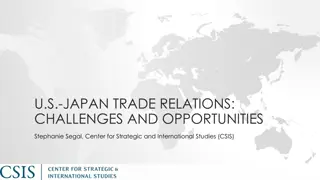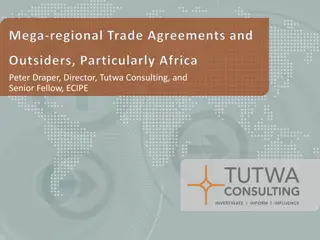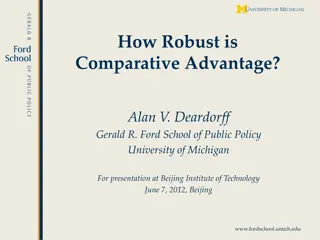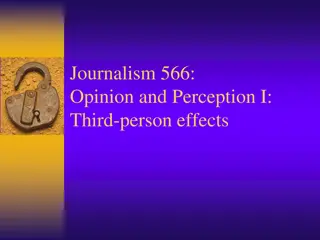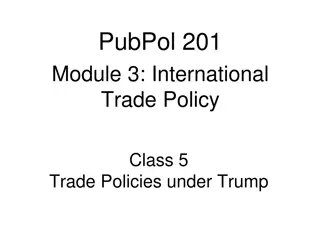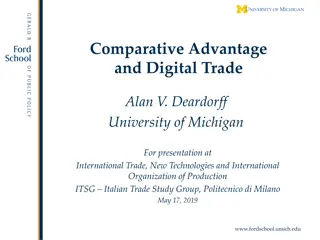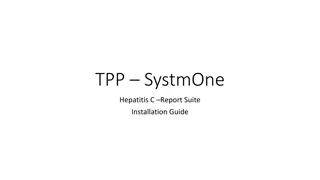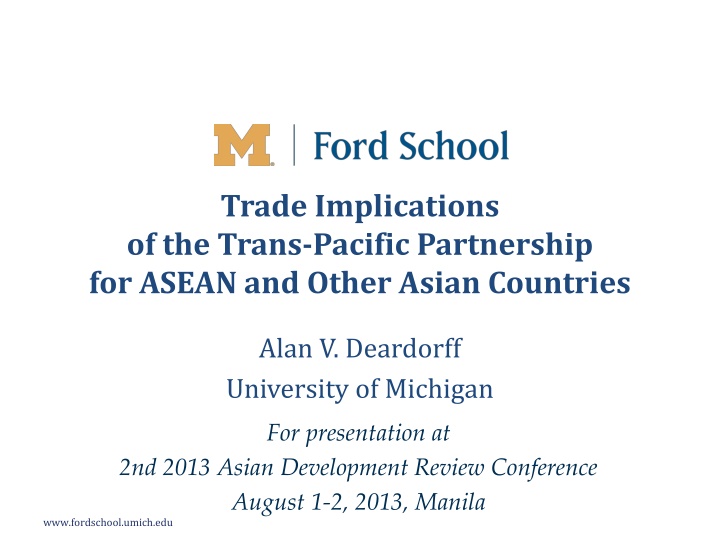
Implications of Trans-Pacific Partnership for ASEAN and Asian Countries
Explore the potential trade impacts of the Trans-Pacific Partnership (TPP) on ASEAN countries and other Asian economies. Learn about the intersection of TPP with ASEAN Free Trade Area (AFTA) and the implications on GDP shares. Discover how TPP may influence trade dynamics beyond traditional barriers, affecting various economies in the region.
Download Presentation

Please find below an Image/Link to download the presentation.
The content on the website is provided AS IS for your information and personal use only. It may not be sold, licensed, or shared on other websites without obtaining consent from the author. If you encounter any issues during the download, it is possible that the publisher has removed the file from their server.
You are allowed to download the files provided on this website for personal or commercial use, subject to the condition that they are used lawfully. All files are the property of their respective owners.
The content on the website is provided AS IS for your information and personal use only. It may not be sold, licensed, or shared on other websites without obtaining consent from the author.
E N D
Presentation Transcript
Trade Implications of the Trans-Pacific Partnership for ASEAN and Other Asian Countries Alan V. Deardorff University of Michigan For presentation at 2nd 2013 Asian Development Review Conference August 1-2, 2013, Manila www.fordschool.umich.edu
The Trans-Pacific Partnership (TPP) Currently being negotiated among 12 countries P4 from 2006: New Zealand, Singapore, Brunei Darussalam, Chile Added as TPP from 2008: Australia, Peru, United States, Vietnam Added 2009: Malaysia 2011: Canada, Mexico 2013: Japan 2 www.fordschool.umich.edu
Figure 1 Countries of the TPP and AFTA www.fordschool.umich.edu
The ASEAN Free Trade Area (AFTA) Since 1992 (as reported to WTO) 10 Countries ASEAN-6: Brunei Darussalam, Indonesia, Malaysia, the Philippines, Singapore and Thailand Newer members: Cambodia, Laos, Myanmar and Viet Nam 4 www.fordschool.umich.edu
Figure 2 ASEAN www.fordschool.umich.edu
Other Asia I will also look at 10 other Asian economies not part of TPP or AFTA: Bangladesh, China, Hong Kong, India, Macao, Nepal, Pakistan, South Korea, Sri Lanka, Taiwan 6 www.fordschool.umich.edu
7 www.fordschool.umich.edu
Figure 3 Shares of GDP (@PPP) for TPP, AFTA, and Other Asia Other Asia 42% TPP Only 51% AFTA Only 5% TPP & AFTA 2% 8 www.fordschool.umich.edu
My Issue: How will TPP affect the trade of AFTA and other Asia? Why this is of interest: TPP is large, both geographically and economically TPP overlaps with AFTA and other FTAs TPP will extend well beyond trade and trade barriers (tariffs & NTBs) to include many other issues Some trade related Some domestic 9 www.fordschool.umich.edu
Outline Description of TPP Overlaps of TPP with AFTA and other Asian FTAs Major trading partners of TPP and Asian economies Effects of TPP by economy 10 www.fordschool.umich.edu
TPP Free Trade Area (FTA) Zero tariffs on (almost) all goods trade among member countries No change in tariffs on imports from outside; thus mostly unequal tariffs Rules of Origin (ROOs) 11 www.fordschool.umich.edu
TPP Other Trade Issues Trade in Goods Nontariff barriers Trade remedies Rules of origin Trade in Services 12 www.fordschool.umich.edu
TPP Non-Trade Issues Intellectual property protection Competition policy Temporary movement of business persons Labor rights Environmental laws and regulations 13 www.fordschool.umich.edu
TPP Non-Trade Issues Regulatory coherence Digital technologies Financial services Investment 14 www.fordschool.umich.edu
TPP Issues often mentioned, but not explicitly part of TPP State-owned enterprises Currency manipulation 15 www.fordschool.umich.edu
Overlap of TPP with AFTA and other FTAs TPP overlap 4 countries of AFTA: Brunei, Malaysia, Singapore, Vietnam Many FTAs among TPP countries: e.g., Australia- New Zealand, NAFTA, etc. Bilateral FTAs with ASEAN: Australia, Japan, New Zealand Bilateral FTAs of TPP countries with Other Asian economies: e.g., Chile-China, Japan-India, New Zealand-Hong Kong, Peru-S. Korea 16 www.fordschool.umich.edu
Figure 4: Existing FTAs & EIAs E = Economic Integration Agreement F = FTA 17 www.fordschool.umich.edu
Overlap of TPP with AFTA and other FTAs Messages: TPP countries are already heavily linked by existing FTAs: Most are Economic Integration Agreements (EIAs). Of 66 possible pairs of countries in the 12-country TPP, 40 already have FTAs, all but 6 of which are EIAs. 18 www.fordschool.umich.edu
Overlap of TPP with AFTA and other FTAs Messages: For the 4 countries in both AFTA and TPP Only one pair (Brunei-Singapore) has an EIA. Others have only FTAs, thus subject to greater economic integration as a result of the TPP. They are in 17 of possible 32 FTAs with other TPP countries, all-but-one are EIAs Only Singapore has EIA with US, which is probably most demanding as TPP 19 www.fordschool.umich.edu
Overlap of TPP with AFTA and other FTAs Messages: The six countries that are part of AFTA but not part of the TPP already have FTAs with three of the non-AFTA TPP countries Australia, Japan, and New Zealand negotiated between them and ASEAN as a group. 20 www.fordschool.umich.edu
Overlap of TPP with AFTA and other FTAs Messages: Among the 10 countries in Other Asia, 3 (China, India, and South Korea) have FTAs with the AFTA countries and at least one with the non-AFTA TPP countries. 21 www.fordschool.umich.edu
Trade Effects of TPP Three main effects Trade creation: Import from partner what was previously produced at home Trade diversion: Import from partner what was previously imported from 3rd country Reversal of trade diversion: Import from new partner what had been diverted to partner in prior FTA ( trade un-diversion ? trade reversion ) Also one non-effect: TPP will have little effect on trade with countries already subject to FTA 22 www.fordschool.umich.edu
Trade Effects of TPP Focus mainly on largest trade flows Top-five partners for exports Top-five partners for imports 23 www.fordschool.umich.edu
24 www.fordschool.umich.edu
25 www.fordschool.umich.edu
Trade Effects of TPP In the paper I talk through the effects on individual countries and groups of countries in TPP, AFTA, and Other Asia Discussion is based on the presence and absence of FTAs in Figure 4 covering the major trade flows indicated in Figures 5 & 6 Here I will just mention a few examples 26 www.fordschool.umich.edu
Australia Largest trade partner is China, for both exports and imports. TPP will divert trade from China TPP will eliminate tariffs with only one top trading partner: Japan Already has FTAs with 7 other TPP countries, so little effect except on trade with Japan Japan and Australia will both benefit from reversing Australia s trade diversion to US Australia therefore likely to benefit 27 www.fordschool.umich.edu
Japan Largest trade partner is China Major trade partners in TPP are US for exports and imports Australia for imports TPP will be primarily a Japan-US FTA Will reverse trade diversion due to NAFTA and other US FTAs Will cause substantial trade diversion away from China Net effect on Japan is hard to say 28 www.fordschool.umich.edu
Countries of both TPP & AFTA Brunei, Malaysia, and Vietnam All have FTAs already with major trading partners except US These FTAs have diverted their trade from US TPP will undo that trade diversion They ll benefit Singapore is like the others, except that It already has FTA with US Reversal of trade diversion will occur for trade with Canada and Mexico, but this is small Singapore will benefit, but only a little 29 www.fordschool.umich.edu
Countries in AFTA but not TPP Cambodia, Indonesia, Laos, Myanmar, Philippines, and Thailand All share the ASEAN FTAs with Australia and New Zealand, Japan, China, India, and South Korea TPP will cause some trade diversion away from (AFTA/not TPP) countries by AFTA/TPP members, but these are not major trade partners, so the effect will be small More serious will be trade diversion away from these by Japan and US, which are major trade partners These countries are likely to be harmed by the TPP 30 www.fordschool.umich.edu
Countries Other Asia (not in AFTA or TPP) All of these should expect some loss from trade diversion, tempered somewhat by existing FTAs China Has FTAs with AFTA plus Chile, New Zealand, & Peru But has no FTAs with others, including major trading partners US and Japan Will be a major loser from the TPP 31 www.fordschool.umich.edu
Conclusion Trade effects of TPP on Asian economies will be Non-trivial trade diversion, especially for China Positive in several cases as TPP reverses effects of previous trade diversion 32 www.fordschool.umich.edu



